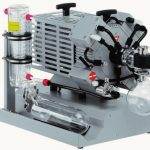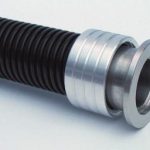Even small chemical plants and laboratories are subject to a safety assessment if they handle flammable solvents: Vacuum networks must not be oversized and they should be built exclusively with chemically resistant materials. Atex-compliant chemistry diaphragm vacuum pumps, in combination with appropriate accessories such as antistatic PTFE tubing, are available for vacuum generation.
Dr. Jürgen Dirscherl
Many popular solvents employed in the chemicals industry are flammable at atmospheric pressure and have a high vapour pressure. Consequently they may form explosive mixtures with air. All plants which handle this kind of substance must be subjected to a safety assessment by the operator. Whereas an Ex assessment is standard practice for large production facilities or pilot plants, this aspect tends to be disregarded in laboratories. The main criterion for Ex classification is normally the quantity of solvent used: 1 to 2 l of solvent per test is generally defined as the threshold.
Numerous laboratory processes involving flammable solvents – like evaporation, distillation and drying – take place under vacuum. Diaphragm vacuum pumps, where all components in contact with the medium are made of chemically resistant materials, have proved especially successful for these applications. Diaphragm pumps offer an excellent basis for avoiding ignition sources due to their freedom from oil, the hermetic sealing of the pumping chamber and the absence of gliding surfaces. This greatly simplifies the hazard assessment.
Single applications
If a vacuum pump is only used for a single application, the hazard assessment is unlikely to present any serious problems. It is generally possible to predict accurately whether or not, and if so how often, explosive gas mixtures may occur based on the type and quantity of solvent and on the process steps. The situation becomes more complicated if more than one process is run. When analysing the safety of a vacuum system, it is essential to consider the external part, for example the laboratory, separately from the internal part in contact with the media being pumped. The results – and the requirements that need to be met – often vary considerably between the internal and external parts of the equipment.
Large rotary or parallel evaporators, vacuum ovens, in which the quantities of solvent are frequently substantial, miniature and pilot plants are among the typical applications for explosion-protected chemistry diaphragm vacuum pumps. Vacuu-brand offers Atex-compliant chemistry diaphragm vacuum pumps with a pumping speed of 1.9 to 8.1 m3/h and an ultimate vacuum of 12 to 2 mbar for occasional pumping of explosive mixtures. They cover a wide range of applications with explosive mixtures in laboratories or pilot plants effectively. Atex chemistry pumping units can also be supplied with an inlet separator and an exhaust vapour condenser for solvent recovery. These components are usually coated with plastic material against breakage. Due to electrostatic discharge, this is not possible for Atex components. Therefore, protection against damage and breakage must be provided by the user, for instance through installation in a cabinet or hood.
Vacuum networks
A safety analysis of the internal part of a vacuum network needs to differentiate between the network itself (internal part with the tubing, connection modules, vacuum controller, etc.) and the inside of the vacuum pump (owing to the compression that takes place here to atmospheric pres-sure). The risk of explosion can vary enormously, depending on the size of the vacuum network and the average quantity and composition of the pumped media. Central vacuum systems supplying e.g. a whole lab building represent an inherent risk because explosive mixtures are liable to be formed by the pumped substances mixed with air. Important is on the one hand the quantity of these substances, due to the large number of users, and on the other hand the diversity of the applications, for example if the pressure in the system is frequently close to atmospheric pressure because of a high gas load. Local vacuum networks that only supply a single lab bench or room are far less problematic. All users are in direct contact with one another and can take suitable corrective action such as evacuation or purging with inert gas as and when necessary.
As a general rule, vacuum networks should be designed as small as possible (local networks rather than central vacuum supplies), built with chemically inert materials and kept permanently under vacuum with the help of a vacuum management system. This narrows the flammability ranges of the pumped media and ensures that the inside of the network remains clean at all times. If a local network is permanently under vacuum, the question arises as to whether a hazardous area even exists at all on the inside. This has to be decided by the operator; past experience shows that for many standard laboratory networks the answer is no. In this case, conventional vacuum network components (e.g. Vacuubrand Vacuu∙LAN) and vacuum controllers or vacuum management systems can be used without Ex approval providing the work environment is not classified as an Ex zone.
A different assessment may well have to be carried out for the inside of the pump which evacuates the network, because the gases are compressed to atmospheric pressure on the outlet side. In addition, typically, larger quantities of solvents are present compared to stand-alone pumps, including unknown mixtures of pumped media. Whereas complex safety measures such as inertisation used to be necessary in critical applications to prevent explosive mixtures from forming inside the pump, the above-mentioned Atex chemistry pumps and pumping units are approved for occasional pumping of explosive atmospheres. They represent an efficient alternative whenever there is a likelihood of the formation of explosive mixtures in the network or in the pump.
Accessories
Laboratories often tend to overlook the fact that not only the Ex systems themselves but also all accessory components have to comply with Atex requirements. Amongst other things, the vacuum lines from the Ex pump to the rotary evaporator or the drying chamber must be antistatic. Stainless steel hoses are frequently used for Ex applications. However, the pumped media will accumulate in the corrugations of the tubing. This can easily lead to corrosion of the thin-walled stainless steel and ultimately to leakage. PTFE is a far superior hose material when it comes to chemical resistance. Unfortunately, though, conventional PTFE tubes are extremely rigid, especially if they have a large diameter. The Vacuubrand range now includes flexible tubing made of antistatic PTFE with a large nominal diameter and an almost even inside wall. In addition to boasting excellent fluidic properties, it also prevents the accumulation of condensate.
Hall 5.1, Booth F3
cpp 404
Näheres zu den Produkten
Ausstellungsbus auf Tour
Literatur – Vakuumtechnik in der industriellen Praxis
Praxislexikon Statische Elektrizität
Share:








